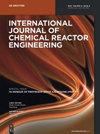Enhancement investigation of mass transfer and mixing performance in the static mixers with three twisted leaves
IF 1.6
4区 工程技术
Q3 Chemical Engineering
International Journal of Chemical Reactor Engineering
Pub Date : 2023-04-07
DOI:10.1515/ijcre-2023-0021
引用次数: 0
Abstract
Abstract The mass transfer and mixing performance in the static mixers with three twisted leaves (TKSM) were investigated by the computational fluid dynamics coupled population balance model. A high-precision and efficient gas-liquid two phase model were evaluated by considering several drag models based on experimental bubble size distributions. The bubble size prediction matched well with experimental data and the mean relative error of Sauter mean diameter (d32) between the prediction and experiment values is 4.93 %. The drag correction factor considering hindering effect of small bubbles can improve the accuracy of cumulative probability distribution (CPD) prediction by 10.06 %. Bubble breakup capacity is quantized via gas-liquid interfacial area, and an empirical correlation between Eo and bubble aspect ratio (γ) have been proposed to predict morphological characteristics of bubble swarms. The effect of liquid Re on the mass transfer rate is much more significant than that of gas volume fraction (αd). The coefficients of variation profiles show that RL-TKSM has better mixing efficiency compared with LL-TKSM and perfect mixing could be achieved after seven mixing elements. The micro mixing efficiency of RL-TKSM is 1.06–1.14 times that of LL-TKSM, which indicates that RL-TKSM has excellent mixing and mass transfer performances.三扭叶静态混合器传质与混合性能的强化研究
摘要采用计算流体力学耦合种群平衡模型研究了三扭叶静态混合器(TKSM)的传质和混合性能。基于实验气泡尺寸分布,考虑了几种阻力模型,对一种高精度、高效的气液两相模型进行了评价。气泡尺寸预测与实验数据吻合良好,Sauter平均直径(d32)预测值与实验值之间的平均相对误差为4.93%。考虑小气泡阻碍作用的阻力修正因子可以将累积概率分布(CPD)预测的准确率提高10.06%。气泡破碎能力通过气液界面面积来量化,并提出了Eo和气泡纵横比(γ)之间的经验相关性来预测气泡群的形态特征。液体Re对传质速率的影响远大于气体体积分数(αd)。变化曲线的系数表明,RL-TKSM比LL-TKSM具有更好的混合效率,并且在七个混合元件之后可以实现完美的混合。RL-TKSM的微混合效率是LL-TKSM微混合效率的1.06–1.14倍,表明RL-TKSM具有优异的混合和传质性能。
本文章由计算机程序翻译,如有差异,请以英文原文为准。
求助全文
约1分钟内获得全文
求助全文
来源期刊
CiteScore
2.80
自引率
12.50%
发文量
107
审稿时长
3 months
期刊介绍:
The International Journal of Chemical Reactor Engineering covers the broad fields of theoretical and applied reactor engineering. The IJCRE covers topics drawn from the substantial areas of overlap between catalysis, reaction and reactor engineering. The journal is presently edited by Hugo de Lasa and Charles Xu, counting with an impressive list of Editorial Board leading specialists in chemical reactor engineering. Authors include notable international professors and R&D industry leaders.

 求助内容:
求助内容: 应助结果提醒方式:
应助结果提醒方式:


